Identifying factors influencing on the cash flow of construction companies: Evidence from Vietnam stock exchange
Good management of cash flow will help managers control cost estimates, control plan implementation as well as control additional costs, ensuring project success. Therefore, identifying the factors
influencing the cash flow of enterprises helps create synchronous solutions to improve the efficiency of cash flow management, contributing for improving the operational efficiency of the enterprises. This study is based on a survey to determine the factors influencing the cash flow through
the questionnaires and interviews of 105 construction companies listed on the Vietnam Stock Exchange in 2018. The study conducts descriptive statistics analysis of surveyed enterprises; check
the Exploratory Factor Analysis (EFA) analysis conditions to determine the groups of influencing
factors on cash flow in construction companies listed on the Vietnam Stock Exchange. At the same
time, this study remains to check a sample T-test with a value set to 3.0 and 5% reliability and
analysis of EFA discovery factors to select components with the highest coefficients and load components. Based on the EFA analysis results, the study finds six main groups of factors affecting the
cash flow of construction companies. They are: macro environment; construction period; payables
and receivables; construction cost; retention; loan payment and tax. The study also shows that the
effect of variables to cash flow management varied with a mean value from 0.17 to 0.518. Based
on the research results, the authors provide some recommendations to strengthen cash flow management in construction companies listed on the Vietnam Stock Exchange
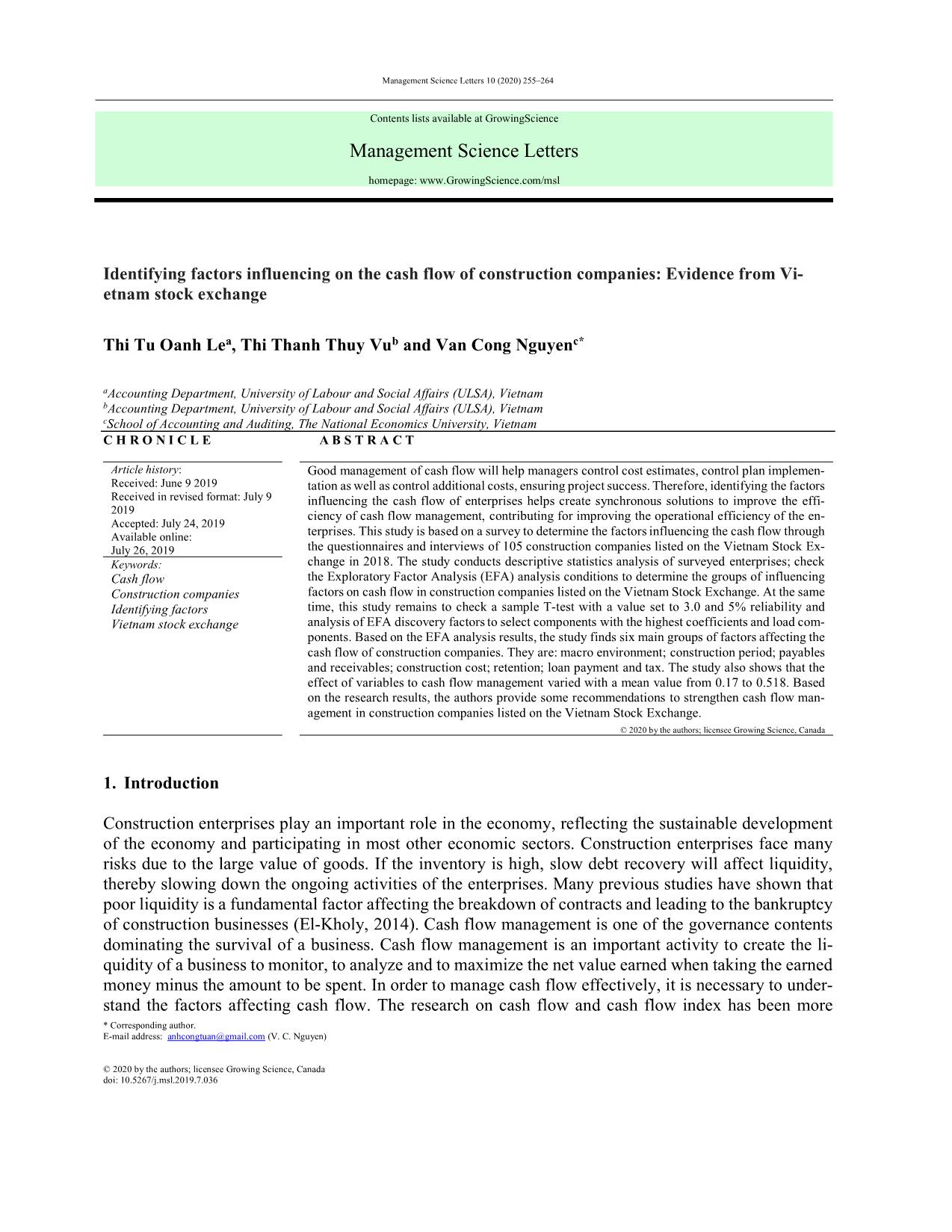
Trang 1
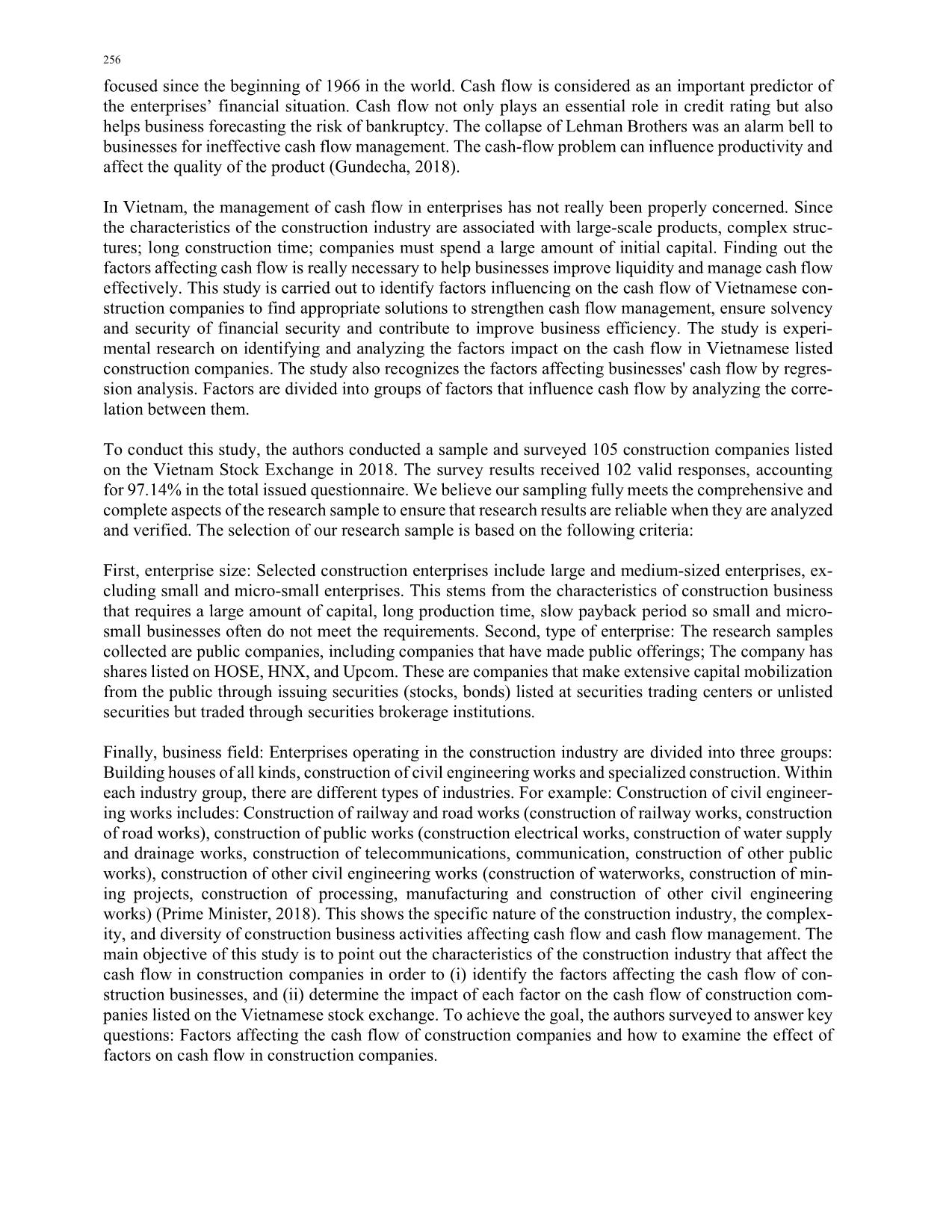
Trang 2
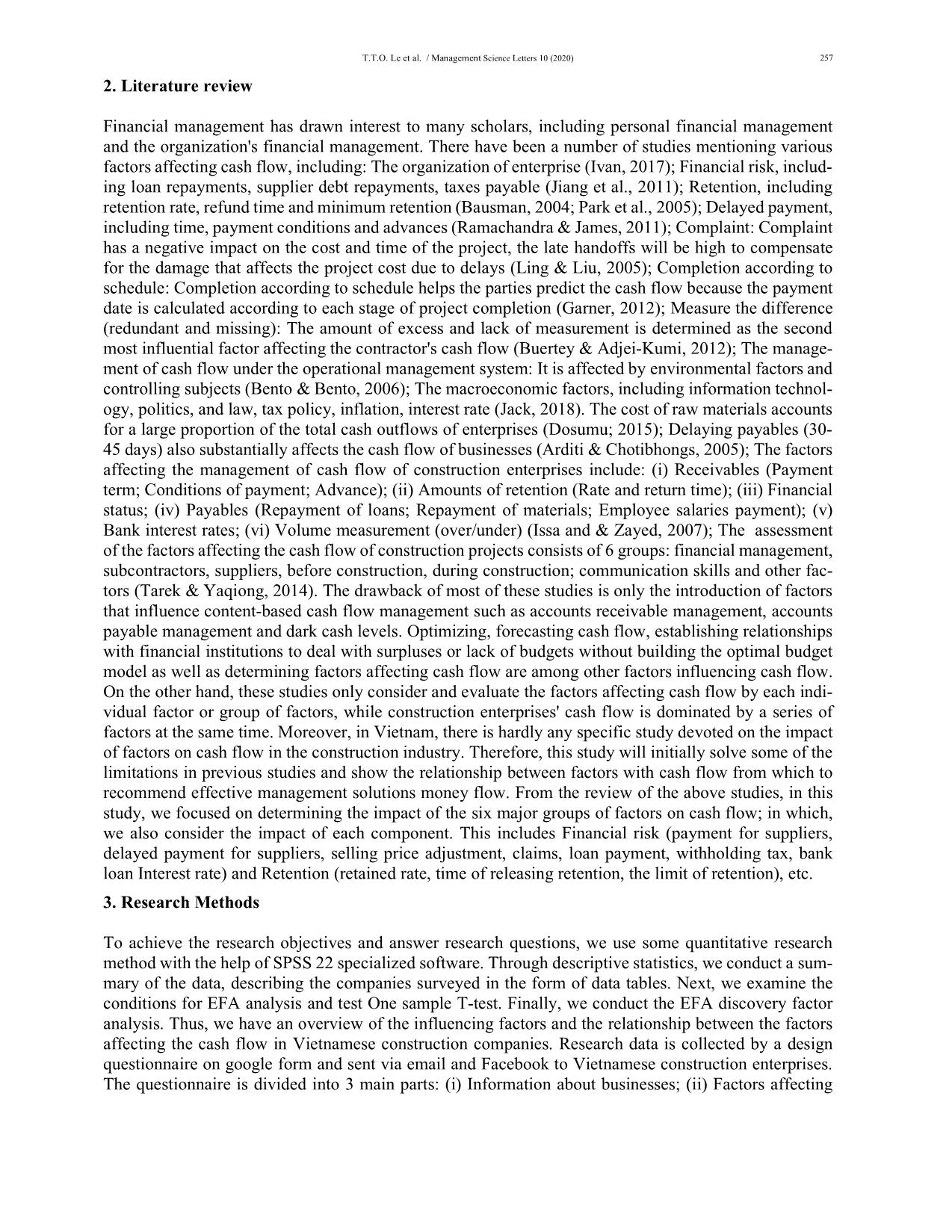
Trang 3
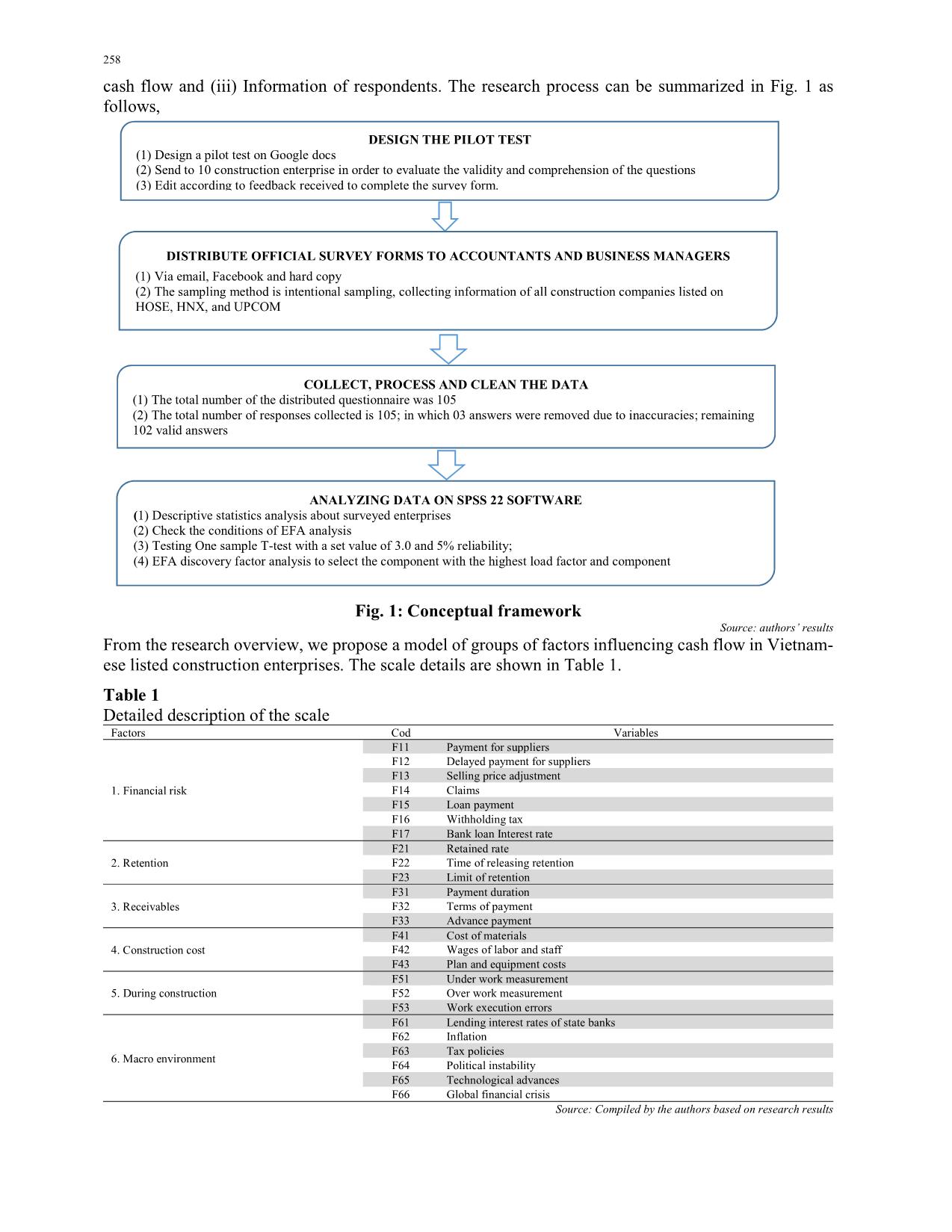
Trang 4
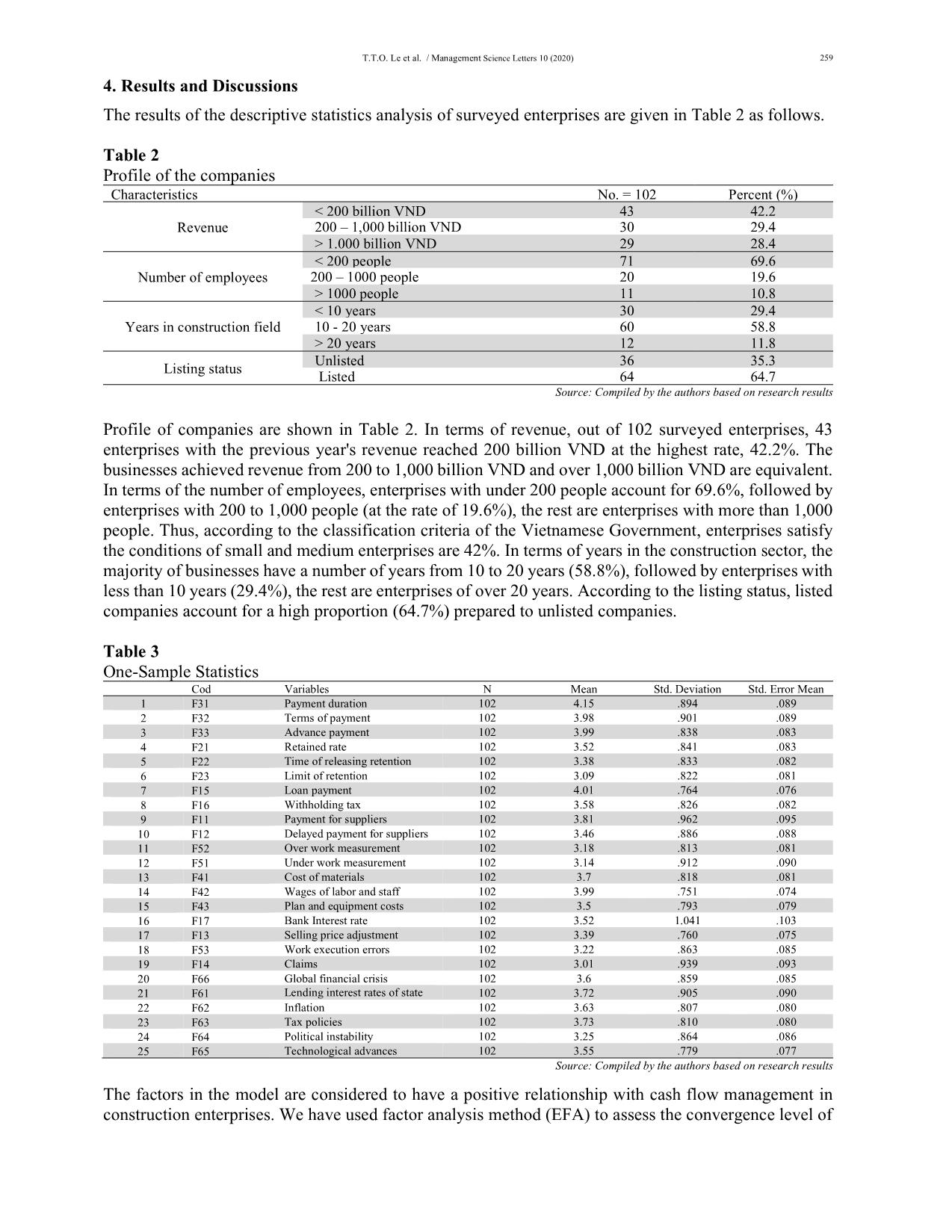
Trang 5
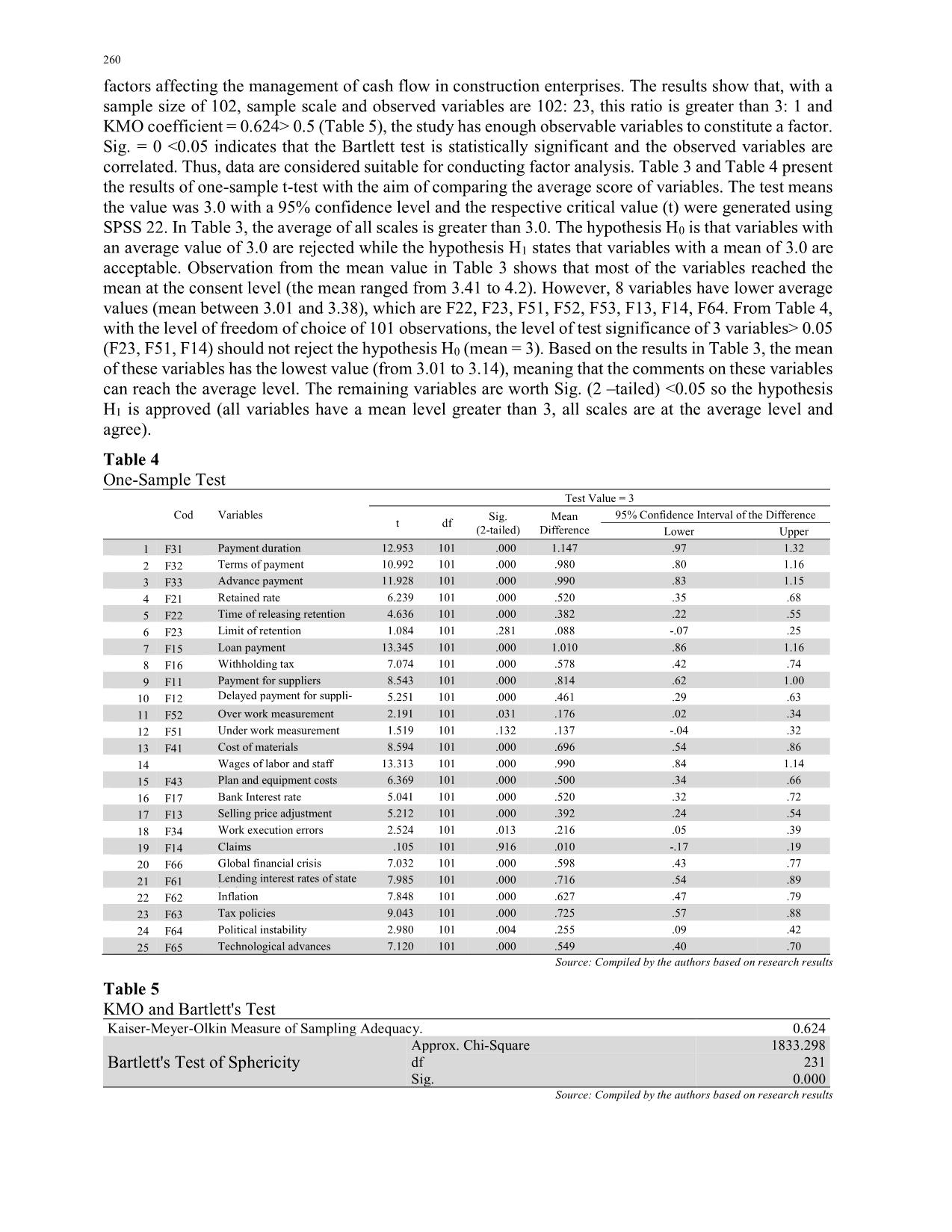
Trang 6
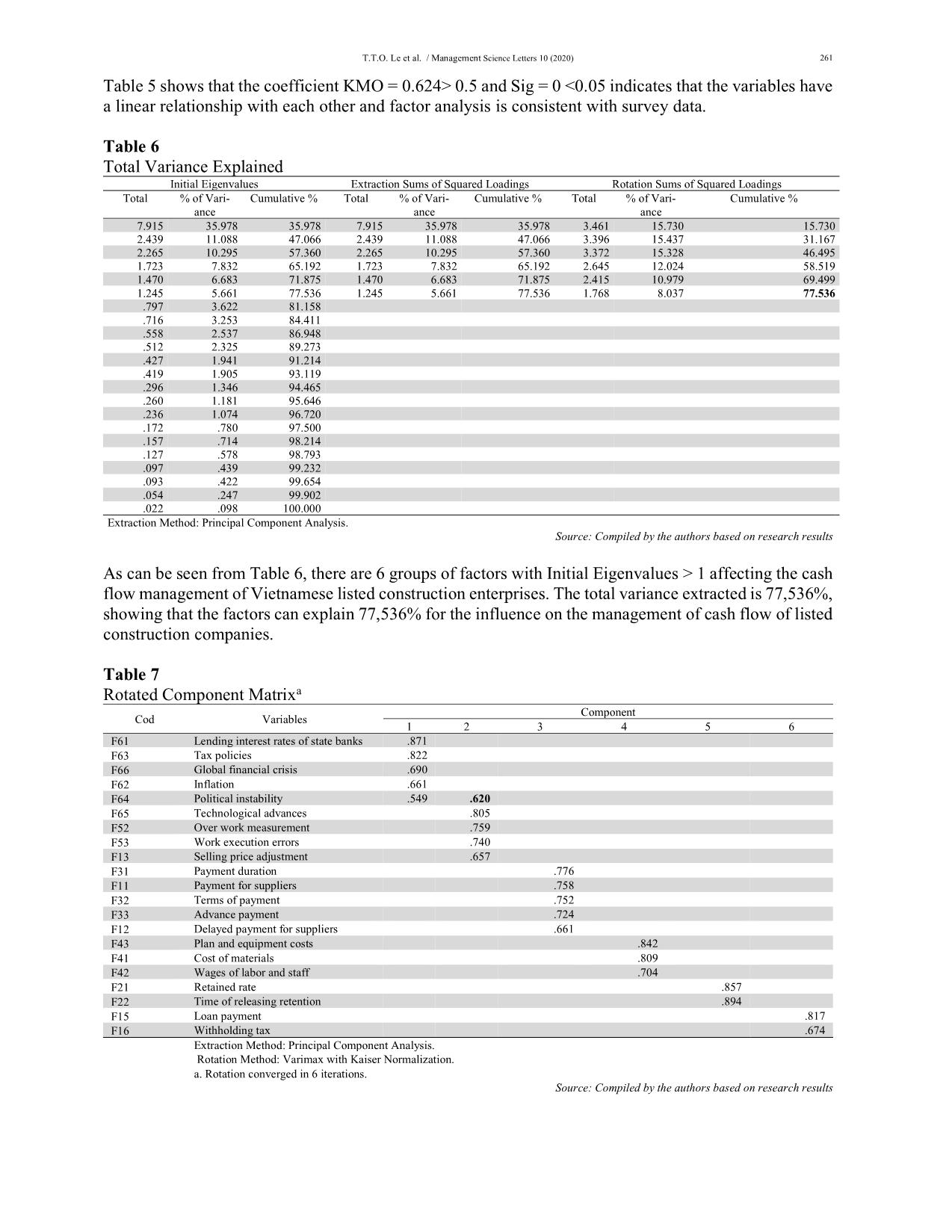
Trang 7
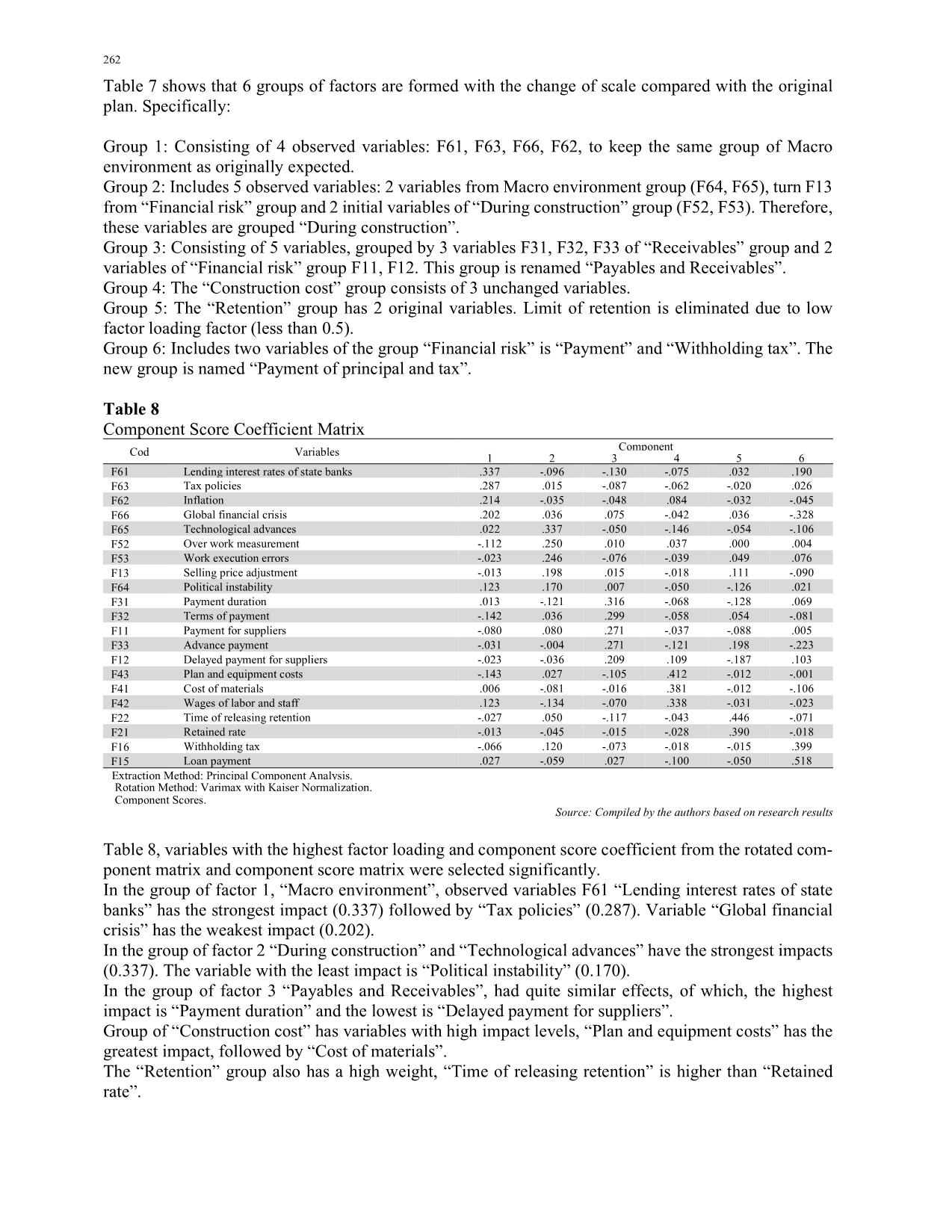
Trang 8
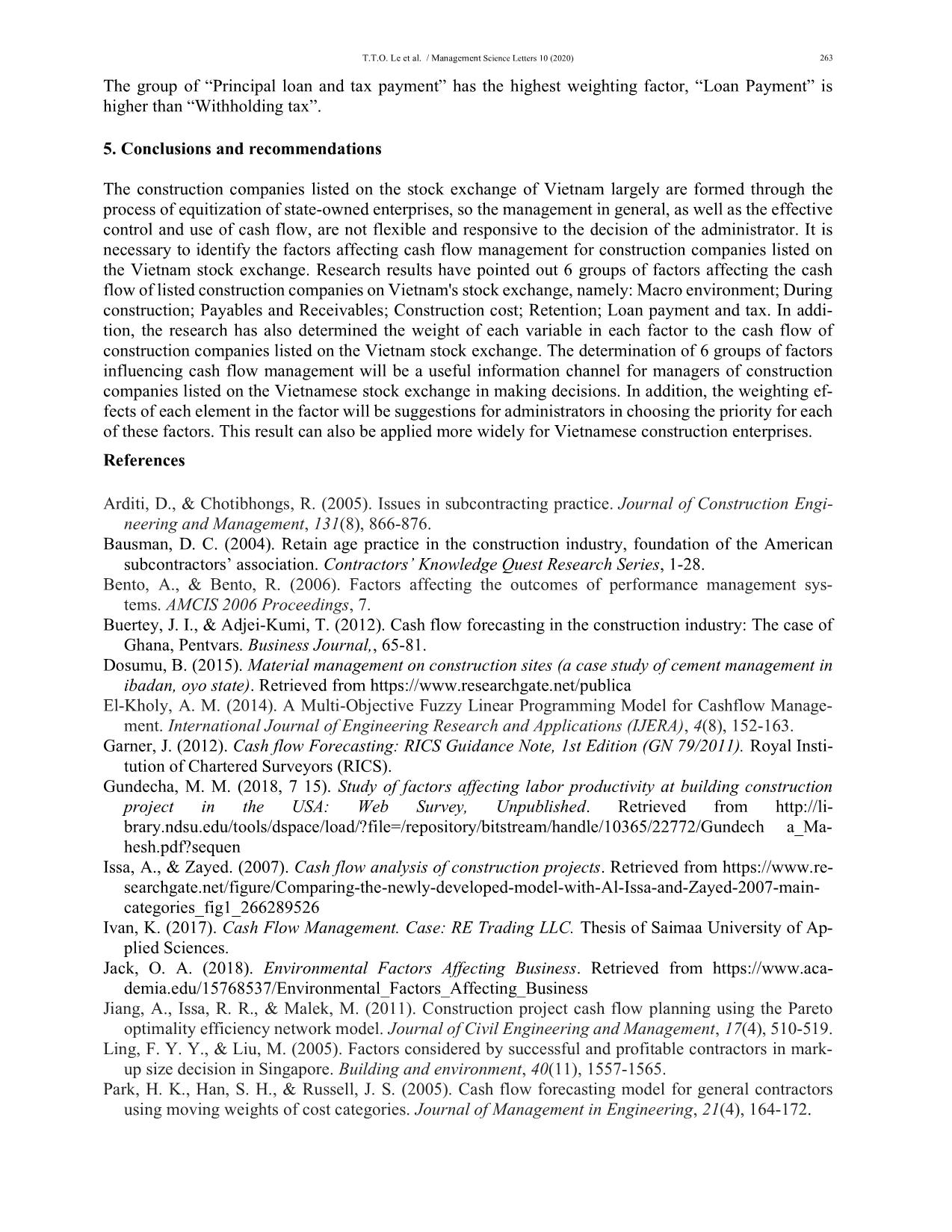
Trang 9
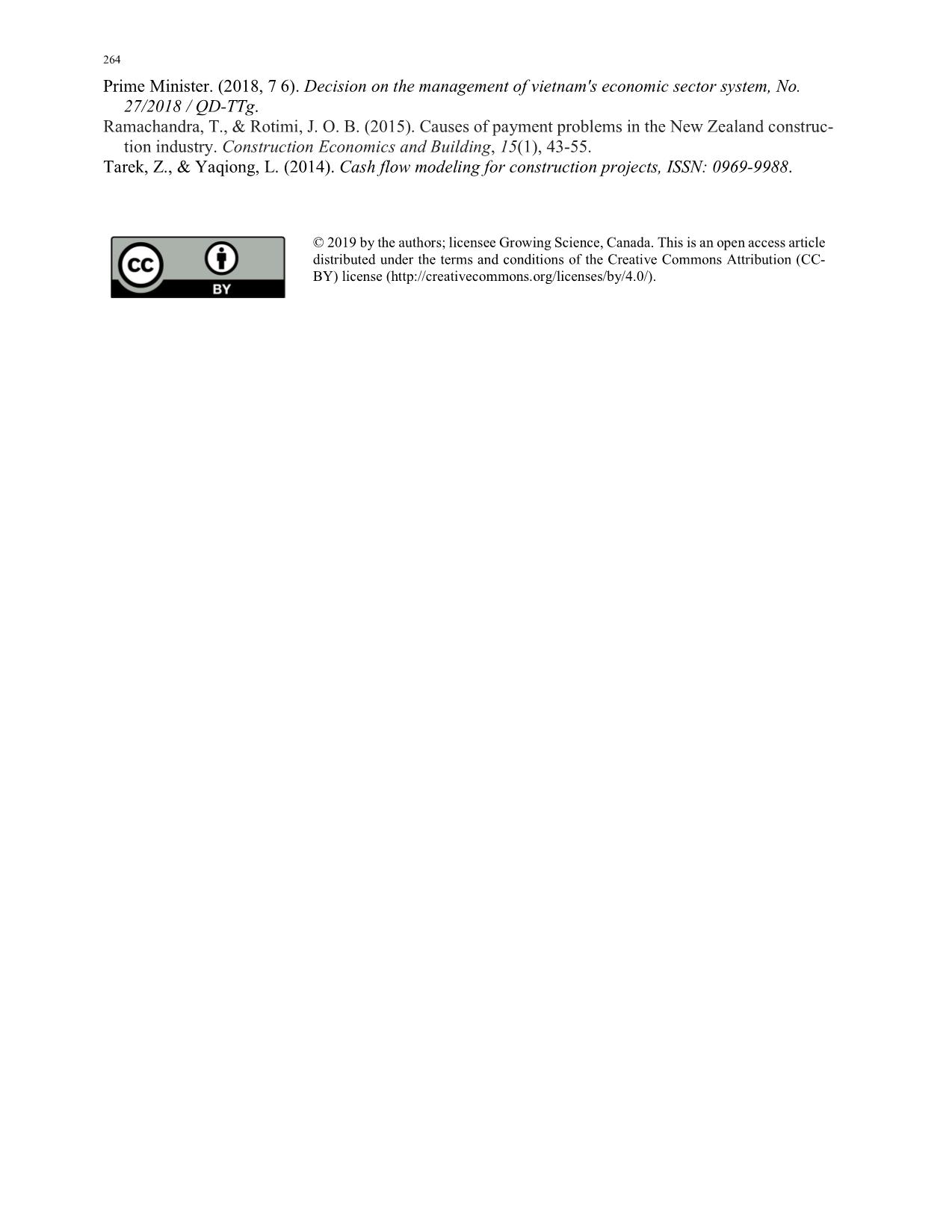
Trang 10
Tóm tắt nội dung tài liệu: Identifying factors influencing on the cash flow of construction companies: Evidence from Vietnam stock exchange
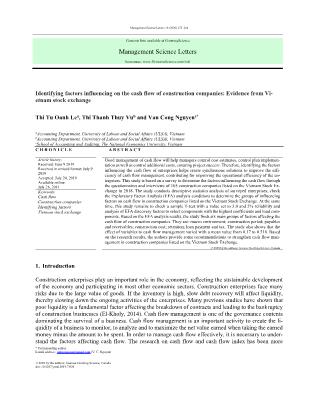
* Corresponding author. E-mail address: anhcongtuan@gmail.com (V. C. Nguyen) © 2020 by the authors; licensee Growing Science, Canada doi: 10.5267/j.msl.2019.7.036 Management Science Letters 10 (2020) 255–264 Contents lists available at GrowingScience Management Science Letters homepage: www.GrowingScience.com/msl Identifying factors influencing on the cash flow of construction companies: Evidence from Vi- etnam stock exchange Thi Tu Oanh Lea, Thi Thanh Thuy Vub and Van Cong Nguyenc* aAccounting Department, University of Labour and Social Affairs (ULSA), Vietnam bAccounting Department, University of Labour and Social Affairs (ULSA), Vietnam cSchool of Accounting and Auditing, The National Economics University, Vietnam C H R O N I C L E A B S T R A C T Article history: Received: June 9 2019 Received in revised format: July 9 2019 Accepted: July 24, 2019 Available online: July 26, 2019 Good management of cash flow will help managers control cost estimates, control plan implemen- tation as well as control additional costs, ensuring project success. Therefore, identifying the factors influencing the cash flow of enterprises helps create synchronous solutions to improve the effi- ciency of cash flow management, contributing for improving the operational efficiency of the en- terprises. This study is based on a survey to determine the factors influencing the cash flow through the questionnaires and interviews of 105 construction companies listed on the Vietnam Stock Ex- change in 2018. The study conducts descriptive statistics analysis of surveyed enterprises; check the Exploratory Factor Analysis (EFA) analysis conditions to determine the groups of influencing factors on cash flow in construction companies listed on the Vietnam Stock Exchange. At the same time, this study remains to check a sample T-test with a value set to 3.0 and 5% reliability and analysis of EFA discovery factors to select components with the highest coefficients and load com- ponents. Based on the EFA analysis results, the study finds six main groups of factors affecting the cash flow of construction companies. They are: macro environment; construction period; payables and receivables; construction cost; retention; loan payment and tax. The study also shows that the effect of variables to cash flow management varied with a mean value from 0.17 to 0.518. Based on the research results, the authors provide some recommendations to strengthen cash flow man- agement in construction companies listed on the Vietnam Stock Exchange. © 2020 by the authors; licensee Growing Science, Canada Keywords: Cash flow Construction companies Identifying factors Vietnam stock exchange 1. Introduction Construction enterprises play an important role in the economy, reflecting the sustainable development of the economy and participating in most other economic sectors. Construction enterprises face many risks due to the large value of goods. If the inventory is high, slow debt recovery will affect liquidity, thereby slowing down the ongoing activities of the enterprises. Many previous studies have shown that poor liquidity is a fundamental factor affecting the breakdown of contracts and leading to the bankruptcy of construction businesses (El-Kholy, 2014). Cash flow management is one of the governance contents dominating the survival of a business. Cash flow management is an important activity to create the li- quidity of a business to monitor, to analyze and to maximize the net value earned when taking the earned money minus the amount to be spent. In order to manage cash flow effectively, it is necessary to under- stand the factors affecting cash flow. The research on cash flow and cash flow index has been more 256 focused since the beginning of 1966 in the world. Cash flow is considered as an important predictor of the enterprises’ financial situation. Cash flow not only plays an essential role in credit rating but also helps business forecasting the risk of bankruptcy. The collapse of Lehman Brothers was an alarm bell to businesses for ineffective cash flow management. The cash-flow problem can influence productivity and affect the quality of the product (Gundecha, 2018). In Vietnam, the management of cash flow in enterprises has not really been properly concerned. Since the characteristics of the construction industry are associated with large-scale products, complex struc- tures; long construction time; companies must spend a large amount of initial capital. Finding out the factors affecting cash flow is really necessary to help businesses improve liquidity and manage cash flow effectively. This study is carried out to identify factors influencing on the cash flow of Vietnamese con- struction companies to find appropriate solutions to strengthen cash flow management, ensure solvency and security of financial security and contribute to improve business efficiency. The study is experi- mental research on identifying and analyzing the factors impact on the cash flow in Vietnamese listed construction companies. The study also recognizes the factors affecting businesses' cash flow by regres- sion analysis. Factors are divided into groups of factors that influence cash flow by analyzing the corre- lation between them. To conduct this study, the authors conducted a sample and surveyed 105 construction companies listed on the Vietnam Stock Exchange in 2018. The survey results received 102 valid responses, accounting for 97.14% in the total issued questionnaire. We believe our sampling fully meets the comprehensive and complete aspects of the research sample to ensure that research results are reliable when they are analyzed and verified. The selection of our research sample is based on the following criteria: First, enterprise size: Selected construction enterprises include large and medium-sized enterprises, ... sing SPSS 22. In Table 3, the average of all scales is greater than 3.0. The hypothesis H0 is that variables with an average value of 3.0 are rejected while the hypothesis H1 states that variables with a mean of 3.0 are acceptable. Observation from the mean value in Table 3 shows that most of the variables reached the mean at the consent level (the mean ranged from 3.41 to 4.2). However, 8 variables have lower average values (mean between 3.01 and 3.38), which are F22, F23, F51, F52, F53, F13, F14, F64. From Table 4, with the level of freedom of choice of 101 observations, the level of test significance of 3 variables> 0.05 (F23, F51, F14) should not reject the hypothesis H0 (mean = 3). Based on the results in Table 3, the mean of these variables has the lowest value (from 3.01 to 3.14), meaning that the comments on these variables can reach the average level. The remaining variables are worth Sig. (2 –tailed) <0.05 so the hypothesis H1 is approved (all variables have a mean level greater than 3, all scales are at the average level and agree). Table 4 One-Sample Test Cod Variables Test Value = 3 t df Sig. (2-tailed) Mean Difference 95% Confidence Interval of the Difference Lower Upper 1 F31 Payment duration 12.953 101 .000 1.147 .97 1.32 2 F32 Terms of payment 10.992 101 .000 .980 .80 1.16 3 F33 Advance payment 11.928 101 .000 .990 .83 1.15 4 F21 Retained rate 6.239 101 .000 .520 .35 .68 5 F22 Time of releasing retention 4.636 101 .000 .382 .22 .55 6 F23 Limit of retention 1.084 101 .281 .088 -.07 .25 7 F15 Loan payment 13.345 101 .000 1.010 .86 1.16 8 F16 Withholding tax 7.074 101 .000 .578 .42 .74 9 F11 Payment for suppliers 8.543 101 .000 .814 .62 1.00 10 F12 Delayed payment for suppli- ers 5.251 101 .000 .461 .29 .63 11 F52 Over work measurement 2.191 101 .031 .176 .02 .34 12 F51 Under work measurement 1.519 101 .132 .137 -.04 .32 13 F41 Cost of materials 8.594 101 .000 .696 .54 .86 14 F42 Wages of labor and staff 13.313 101 .000 .990 .84 1.14 15 F43 Plan and equipment costs 6.369 101 .000 .500 .34 .66 16 F17 Bank Interest rate 5.041 101 .000 .520 .32 .72 17 F13 Selling price adjustment 5.212 101 .000 .392 .24 .54 18 F34 Work execution errors 2.524 101 .013 .216 .05 .39 19 F14 Claims .105 101 .916 .010 -.17 .19 20 F66 Global financial crisis 7.032 101 .000 .598 .43 .77 21 F61 Lending interest rates of state banks 7.985 101 .000 .716 .54 .89 22 F62 Inflation 7.848 101 .000 .627 .47 .79 23 F63 Tax policies 9.043 101 .000 .725 .57 .88 24 F64 Political instability 2.980 101 .004 .255 .09 .42 25 F65 Technological advances 7.120 101 .000 .549 .40 .70 Source: Compiled by the authors based on research results Table 5 KMO and Bartlett's Test Kaiser-Meyer-Olkin Measure of Sampling Adequacy. 0.624 Bartlett's Test of Sphericity Approx. Chi-Square 1833.298 df 231 Sig. 0.000 Source: Compiled by the authors based on research results T.T.O. Le et al. / Management Science Letters 10 (2020) 261 Table 5 shows that the coefficient KMO = 0.624> 0.5 and Sig = 0 <0.05 indicates that the variables have a linear relationship with each other and factor analysis is consistent with survey data. Table 6 Total Variance Explained Initial Eigenvalues Extraction Sums of Squared Loadings Rotation Sums of Squared Loadings Total % of Vari- ance Cumulative % Total % of Vari- ance Cumulative % Total % of Vari- ance Cumulative % 7.915 35.978 35.978 7.915 35.978 35.978 3.461 15.730 15.730 2.439 11.088 47.066 2.439 11.088 47.066 3.396 15.437 31.167 2.265 10.295 57.360 2.265 10.295 57.360 3.372 15.328 46.495 1.723 7.832 65.192 1.723 7.832 65.192 2.645 12.024 58.519 1.470 6.683 71.875 1.470 6.683 71.875 2.415 10.979 69.499 1.245 5.661 77.536 1.245 5.661 77.536 1.768 8.037 77.536 .797 3.622 81.158 .716 3.253 84.411 .558 2.537 86.948 .512 2.325 89.273 .427 1.941 91.214 .419 1.905 93.119 .296 1.346 94.465 .260 1.181 95.646 .236 1.074 96.720 .172 .780 97.500 .157 .714 98.214 .127 .578 98.793 .097 .439 99.232 .093 .422 99.654 .054 .247 99.902 .022 .098 100.000 Extraction Method: Principal Component Analysis. Source: Compiled by the authors based on research results As can be seen from Table 6, there are 6 groups of factors with Initial Eigenvalues > 1 affecting the cash flow management of Vietnamese listed construction enterprises. The total variance extracted is 77,536%, showing that the factors can explain 77,536% for the influence on the management of cash flow of listed construction companies. Table 7 Rotated Component Matrixa Cod Variables Component 1 2 3 4 5 6 F61 Lending interest rates of state banks .871 F63 Tax policies .822 F66 Global financial crisis .690 F62 Inflation .661 F64 Political instability .549 .620 F65 Technological advances .805 F52 Over work measurement .759 F53 Work execution errors .740 F13 Selling price adjustment .657 F31 Payment duration .776 F11 Payment for suppliers .758 F32 Terms of payment .752 F33 Advance payment .724 F12 Delayed payment for suppliers .661 F43 Plan and equipment costs .842 F41 Cost of materials .809 F42 Wages of labor and staff .704 F21 Retained rate .857 F22 Time of releasing retention .894 F15 Loan payment .817 F16 Withholding tax .674 Extraction Method: Principal Component Analysis. Rotation Method: Varimax with Kaiser Normalization. a. Rotation converged in 6 iterations. Source: Compiled by the authors based on research results 262 Table 7 shows that 6 groups of factors are formed with the change of scale compared with the original plan. Specifically: Group 1: Consisting of 4 observed variables: F61, F63, F66, F62, to keep the same group of Macro environment as originally expected. Group 2: Includes 5 observed variables: 2 variables from Macro environment group (F64, F65), turn F13 from “Financial risk” group and 2 initial variables of “During construction” group (F52, F53). Therefore, these variables are grouped “During construction”. Group 3: Consisting of 5 variables, grouped by 3 variables F31, F32, F33 of “Receivables” group and 2 variables of “Financial risk” group F11, F12. This group is renamed “Payables and Receivables”. Group 4: The “Construction cost” group consists of 3 unchanged variables. Group 5: The “Retention” group has 2 original variables. Limit of retention is eliminated due to low factor loading factor (less than 0.5). Group 6: Includes two variables of the group “Financial risk” is “Payment” and “Withholding tax”. The new group is named “Payment of principal and tax”. Table 8 Component Score Coefficient Matrix Cod Variables Component 1 2 3 4 5 6 F61 Lending interest rates of state banks .337 -.096 -.130 -.075 .032 .190 F63 Tax policies .287 .015 -.087 -.062 -.020 .026 F62 Inflation .214 -.035 -.048 .084 -.032 -.045 F66 Global financial crisis .202 .036 .075 -.042 .036 -.328 F65 Technological advances .022 .337 -.050 -.146 -.054 -.106 F52 Over work measurement -.112 .250 .010 .037 .000 .004 F53 Work execution errors -.023 .246 -.076 -.039 .049 .076 F13 Selling price adjustment -.013 .198 .015 -.018 .111 -.090 F64 Political instability .123 .170 .007 -.050 -.126 .021 F31 Payment duration .013 -.121 .316 -.068 -.128 .069 F32 Terms of payment -.142 .036 .299 -.058 .054 -.081 F11 Payment for suppliers -.080 .080 .271 -.037 -.088 .005 F33 Advance payment -.031 -.004 .271 -.121 .198 -.223 F12 Delayed payment for suppliers -.023 -.036 .209 .109 -.187 .103 F43 Plan and equipment costs -.143 .027 -.105 .412 -.012 -.001 F41 Cost of materials .006 -.081 -.016 .381 -.012 -.106 F42 Wages of labor and staff .123 -.134 -.070 .338 -.031 -.023 F22 Time of releasing retention -.027 .050 -.117 -.043 .446 -.071 F21 Retained rate -.013 -.045 -.015 -.028 .390 -.018 F16 Withholding tax -.066 .120 -.073 -.018 -.015 .399 F15 Loan payment .027 -.059 .027 -.100 -.050 .518 Extraction Method: Principal Component Analysis. Rotation Method: Varimax with Kaiser Normalization. Component Scores. Source: Compiled by the authors based on research results Table 8, variables with the highest factor loading and component score coefficient from the rotated com- ponent matrix and component score matrix were selected significantly. In the group of factor 1, “Macro environment”, observed variables F61 “Lending interest rates of state banks” has the strongest impact (0.337) followed by “Tax policies” (0.287). Variable “Global financial crisis” has the weakest impact (0.202). In the group of factor 2 “During construction” and “Technological advances” have the strongest impacts (0.337). The variable with the least impact is “Political instability” (0.170). In the group of factor 3 “Payables and Receivables”, had quite similar effects, of which, the highest impact is “Payment duration” and the lowest is “Delayed payment for suppliers”. Group of “Construction cost” has variables with high impact levels, “Plan and equipment costs” has the greatest impact, followed by “Cost of materials”. The “Retention” group also has a high weight, “Time of releasing retention” is higher than “Retained rate”. T.T.O. Le et al. / Management Science Letters 10 (2020) 263 The group of “Principal loan and tax payment” has the highest weighting factor, “Loan Payment” is higher than “Withholding tax”. 5. Conclusions and recommendations The construction companies listed on the stock exchange of Vietnam largely are formed through the process of equitization of state-owned enterprises, so the management in general, as well as the effective control and use of cash flow, are not flexible and responsive to the decision of the administrator. It is necessary to identify the factors affecting cash flow management for construction companies listed on the Vietnam stock exchange. Research results have pointed out 6 groups of factors affecting the cash flow of listed construction companies on Vietnam's stock exchange, namely: Macro environment; During construction; Payables and Receivables; Construction cost; Retention; Loan payment and tax. In addi- tion, the research has also determined the weight of each variable in each factor to the cash flow of construction companies listed on the Vietnam stock exchange. The determination of 6 groups of factors influencing cash flow management will be a useful information channel for managers of construction companies listed on the Vietnamese stock exchange in making decisions. In addition, the weighting ef- fects of each element in the factor will be suggestions for administrators in choosing the priority for each of these factors. This result can also be applied more widely for Vietnamese construction enterprises. References Arditi, D., & Chotibhongs, R. (2005). Issues in subcontracting practice. Journal of Construction Engi- neering and Management, 131(8), 866-876. Bausman, D. C. (2004). Retain age practice in the construction industry, foundation of the American subcontractors’ association. Contractors’ Knowledge Quest Research Series, 1-28. Bento, A., & Bento, R. (2006). Factors affecting the outcomes of performance management sys- tems. AMCIS 2006 Proceedings, 7. Buertey, J. I., & Adjei-Kumi, T. (2012). Cash flow forecasting in the construction industry: The case of Ghana, Pentvars. Business Journal,, 65-81. Dosumu, B. (2015). Material management on construction sites (a case study of cement management in ibadan, oyo state). Retrieved from https://www.researchgate.net/publica El-Kholy, A. M. (2014). A Multi-Objective Fuzzy Linear Programming Model for Cashflow Manage- ment. International Journal of Engineering Research and Applications (IJERA), 4(8), 152-163. Garner, J. (2012). Cash flow Forecasting: RICS Guidance Note, 1st Edition (GN 79/2011). Royal Insti- tution of Chartered Surveyors (RICS). Gundecha, M. M. (2018, 7 15). Study of factors affecting labor productivity at building construction project in the USA: Web Survey, Unpublished. Retrieved from brary.ndsu.edu/tools/dspace/load/?file=/repository/bitstream/handle/10365/22772/Gundech a_Ma- hesh.pdf?sequen Issa, A., & Zayed. (2007). Cash flow analysis of construction projects. Retrieved from https://www.re- searchgate.net/figure/Comparing-the-newly-developed-model-with-Al-Issa-and-Zayed-2007-main- categories_fig1_266289526 Ivan, K. (2017). Cash Flow Management. Case: RE Trading LLC. Thesis of Saimaa University of Ap- plied Sciences. Jack, O. A. (2018). Environmental Factors Affecting Business. Retrieved from https://www.aca- demia.edu/15768537/Environmental_Factors_Affecting_Business Jiang, A., Issa, R. R., & Malek, M. (2011). Construction project cash flow planning using the Pareto optimality efficiency network model. Journal of Civil Engineering and Management, 17(4), 510-519. Ling, F. Y. Y., & Liu, M. (2005). Factors considered by successful and profitable contractors in mark- up size decision in Singapore. Building and environment, 40(11), 1557-1565. Park, H. K., Han, S. H., & Russell, J. S. (2005). Cash flow forecasting model for general contractors using moving weights of cost categories. Journal of Management in Engineering, 21(4), 164-172. 264 Prime Minister. (2018, 7 6). Decision on the management of vietnam's economic sector system, No. 27/2018 / QD-TTg. Ramachandra, T., & Rotimi, J. O. B. (2015). Causes of payment problems in the New Zealand construc- tion industry. Construction Economics and Building, 15(1), 43-55. Tarek, Z., & Yaqiong, L. (2014). Cash flow modeling for construction projects, ISSN: 0969-9988. © 2019 by the authors; licensee Growing Science, Canada. This is an open access article distributed under the terms and conditions of the Creative Commons Attribution (CC- BY) license (
File đính kèm:
 identifying_factors_influencing_on_the_cash_flow_of_construc.pdf
identifying_factors_influencing_on_the_cash_flow_of_construc.pdf

